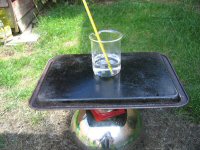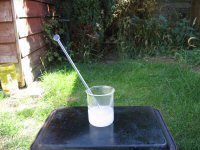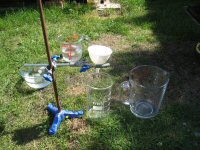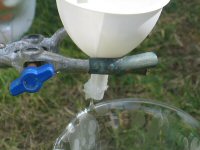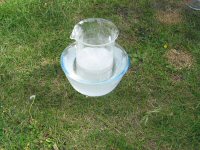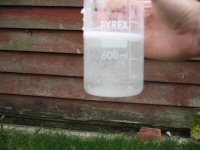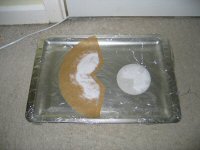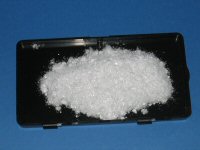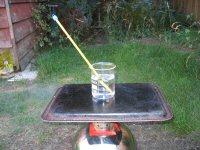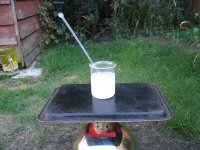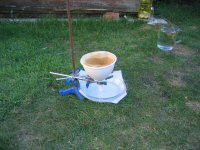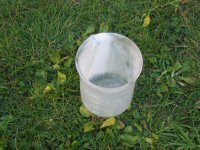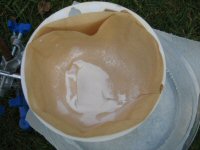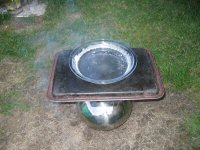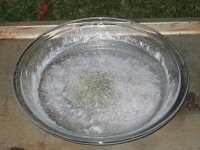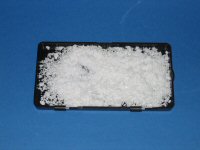2-Acetoxybenzoic Acid (C9H8O4)
2-acetoxybenzoic acid has many names including acetylsalicylic acid, acetol, O-acetylsalicylic acid and entrophen. This page shows how I extracted 2-acetoxybenzoic acid from common aspirin tablets. I'm currently using 2-acetoxybenzoic acid in the synthesis of another compound (details coming soon).A standard tablet is usually made up of 2 parts. The first part of the tablet is the chemicals required to perform the specific task (e.g. pain killers). The second part of the tablet is the binder which simply binds the chemicals from the first part together. The binder also gives the tablet its shape.
In the case of aspirin the first part of the tablet is 2-acetoxybenzoic acid, which is what we are after. The binder in an aspirin tablet is dependent on the manufacturer, but a common aspirin binder consists of potato starch, lactose (C12H22O11) and talc (H2Mg3(SiO3)4). The aspirin tablets I'm using each have 300mg of 2-acetoxybenzoic acid. The weights of the chemicals in the binder are unknown, but the wieght of each tablet is around 340mg, so the total binder weighs approximately 40mg.
The soluability of 2-acetoxybenzoic acid is shown in the following table.
| Substance | Parts |
| Water | 300 |
| Alcohol | 5 - 7 |
| Chloroform | 17 |
| Ether | 20 |
The solubility table shows that 2-acetoxybenzoic acid is fairly soluable in alcohol but quite insoluable in water. These 2 facts can be used to our advantage when trying to seperate the 2-acetoxybenzoic acid from the binder. The following table shows the solubility of the chemicals in the binder.
| Water | Alcohol | |
| Potato Starch | Insoluable | Insoluable |
| Lactose | Soluable | Insoluable |
| Talc | Insoluable | Insoluable |
So to extract the 2-acetoxybenzoic acid we can mix the aspirin tablets with an alcohol and then filter out the insoluable binder.
There are lots of different ways to do this type of experiment, each with advantages and disadvantages. The following sections show some of the different approaches that are available.
 | In the following experiments large amounts of alcohol are evaporated and heated to boiling point. This is extremely dangerous and should NOT be attempted by anyone. The fumes are poisonous, flamable and even explosive under the right conditions. The dangers of the fumes rolling across surfaces and causing flashbacks are very real. When working with alcohol adequate ventilation MUST be used. NEVER work with alcohol indoors. The correct fire fighting equipment should always be at your side and you should always try and remain a safe distance from the setup. NEVER use an open flame to heat the alcohol (I really can't emphesize that enough). I wouldn't give this warning unless it was absolutely necessary. |
Experiment 1 - Promoting Crystal Growth
In the first experiment crystal growth is promoted by adding ice cold water is added to the filtered alcohol to promote 2-acetoxybenzoic acid crystal growth. The crystals are then filtered out. Some losses are expected with this method as adding the cold water to the filterate won't promote 100 percent crystal growth. If a bigger final yield was desired then after filtering the binder out the filterate would have the alcohol evaporated (i.e. no ice cold water would be used).
Experiment 2 - Evaporation
In the second experiment I boil the filtered alcohol down to leave the 2-acetoxybenzoic acid. This method should result in a much greater yield than the first experiment.
| Home |
